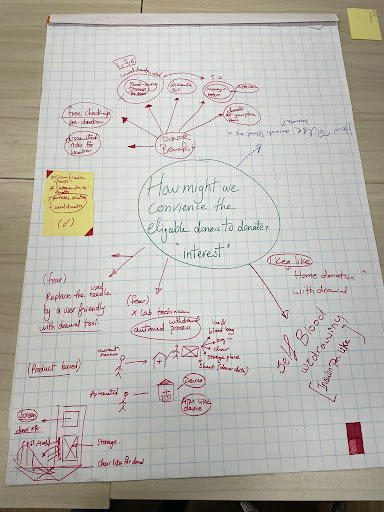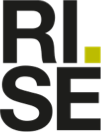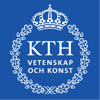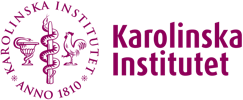The iterative process of creating ideas, prototyping, validating, and developing concepts
By the end of the needs screening phase, we landed on five top commercial needs that tackled completely distinct challenging areas within healthcare. In parallel, we attended a session arranged by RISE to introduce the “concept generation” phase to the team. However, after weeks of needs filtration, research, and analysis, I found it the starting point of making each of us back on the same page. The session included practical exercises on practicing brainstorming as individuals to make each one of us able to contribute to the team’s benefit regardless of our backgrounds.
On the other hand, as a team, we were overwhelmed by the number of needs and the urge to make a final decision that would impact the program positively later on. Personally, I was more empathetic to some needs than others. However, I kept this on hold when applying the scoring matrix and group voting and supported my opinion objectively concerning patients and healthcare system benefits. Later during the decision-making session, we found that we had similar viewpoints on the exact needs, which leaped towards the top three. Afterward, we started setting a plan from the concept generation phase, where all our past observations, insights, research, and spark previously thought ideas come into action.
As a designer, at this stage, I felt recharged to start developing an optimum solution and put all of our prior efforts to good use.
Practically, we started the concept generation phase by sharing all of our background information regarding the top commercial needs with one another as a team. As understanding, the problem acts as the first milestone in creating concepts. Afterward, in parallel, we started working on the root cause of the needs, researching the established solutions, and brainstorming ideas.
The new learning I acquired during the brainstorming exercises was applying the thinking patterns of other industries to our needs. For instance, applying the “barter” pattern to the shortage blood donation challenge. Honestly, this helped us foster new innovative ideas since it acted as a breakthrough when we started getting stuck in repetitive fragmentary ideas. When we applied this method as a team, each of us came up with an average of 15 ideas. Most of the ideas were new, though.
To make the best use of that excessive brainstorming, we wrote them down in simple words on sticky notes to present each idea solely. We then started clustering them to establish categories and refine the individual ideas by building them on each other to develop a mature concept.


One important key factor that turned this concept generation coaching sessions into productive and successful ones is the “brainstorming session rules,” which are referred to by IDEO in the Biodesign book. They pushed us forward to defer judgments on each other’s ideas, stay focused on one topic at a time and go for the quantities in creating ideas rather than perfecting in being visual. We had to run the same exercise on the remaining new needs since we first applied it to only one need. After that, we finally had to choose the lucky need, which we would pursue working on over the rest of the program. Ultimately, we selected a need that tackles the blood supply chain.

As the Biodesign book goes, we as innovators should experiment with diverse methodologies during the concept generation phase. So, we started doing root cause analysis for our final need, framing questions that we need to figure answers for, converting our need statement and criteria to a series of focused questions. For instance, how might we (HMW) convince eligible donors to donate? Based on those questions, we started running brainstorming sessions, each focusing on a question.
Part of being visual is turning our ideas into quick prototypes to express them to the team and seek feedback.
The concept generation phase was so iterative that we rephrased our need statements more than twice upon new insights that we kept discovering during concept testing and validations.
Practically, we have a need statement that sounds convincing at first. Validated with research, we start ideating and getting quite reasonable solutions; we validated on the ground by covering different healthcare sectors and realized this is not the root yet and so forth. After loops of learnings, iterations and by developing a list of pain points, getting back to our need criteria, and considering the actual market constraints, we ultimately landed on a need statement that we are confident of by many proofs.
So, this brings us steps backward to the creative ideation process, but this time it was more efficient since we had way fewer doubts and neglected market concerns. We turned our top ideas into prototypes and became ready to screen them. The ideas were between service and products, which involves technical and physical solutions. They all sounded promising at first, yet each solution solved the problem at a certain point in the patient journey. So, we decided to consider them as stages rather than ideas that could compete against each other. So, the questions were, where is the most required to intervene and make a difference? Which problem is the most crucial at the moment to start with?
It was crucial not to get biased and try being objective-oriented as much as possible. Through the priority matrix with feasibility, desirability, and viability, we chose our final concept. Nevertheless, we kept developing it along the validation process. We started getting solid validations from healthcare representatives, which pushed us towards planning for our strategy and business model.
It was so engaging that we did a lot of tasks that involved physical interactions, from presenting to prototyping, and validation, seeking more understanding about the blood supply chain. From my perspective, the concept generation phase was the most challenging yet the best enjoyable and rewarding.
Nada Mamdouh, CIF Fellow 2021





